Excerpts from Jim Conrad's
Naturalist Newsletter
Note:The terms paper wasp, yellowjacket, hornet and just plain wasp are more useful in northern countries than in the tropics where there are so many in-between type wasp species. I'm calling the ones below paper wasps, but I'm not sure what common name a specialist would call them.
from the September 29, 2008 Newsletter Written in Sabacché and issued from a ciber in nearby Tekit, Yucatán, MÉXICO
A PAPER WASP NEST
Almost at head level on the lowest branches of the very dense, dark-green Guaya, Talisia olivaeformis, tree in my backyard there's a paper-wasp nest about the size of a human adult's head, shown below:

One neat feature of this nest is that you can see how as it was constructed it simply incorporated twigs and leaves occupying the space of the future nest. At the nest's top, look at how twigs enter the nest; they exit on the opposite side. At the nest's bottom you can see how the growing nest is in the process of engulfing a leaf.

Above you can see into the entrance. When this image first appeared on my screen the entrance showed us as nothing but a black hole, but with PhotoShop I overexposed the hole until the hexagonal cells inside showed up -- the honeycomb. Toward the picture's bottom wasps agitated by my presence are swarming out so fast that they're only blurs. Only one stung me, and it wasn't very painful, about like a "sweat-bee's" sting in the North. These little beings are not at all eager to sting.
My neighbors tell me that in the old days people would tear open the nests not only for the honey but also for the cells filled with grubs developing into adult workers. The grubs were considered good eating.
from the November 17, 2008 Newsletter Written mostly written in Yokdzonot and issued from a ciber in Pisté, central Yucatán, MÉXICO
VIEW INSIDE A PAPER WASP NEST
The other day I came upon one with its exterior partly torn away and I thought you might be interested in seeing the layers of hexagonal cells inside it. The picture is below:
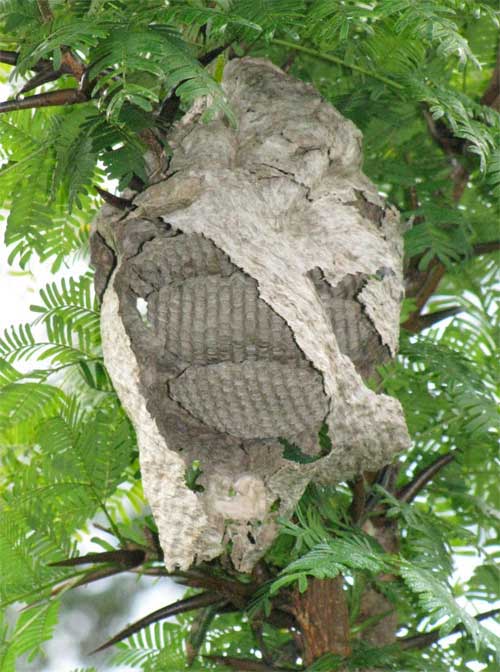
When I showed the picture to a friend here I got the usual report on how tasty the wasp grubs are sautéed with a little salt and chili sauce.
from the December 11, 2011 Newsletter issued from Hacienda Chichen Resort beside Chichén Itzá Ruins, central Yucatán, MÉXICO
WASPS VS ANTS
When I arrived back at the hut about five weeks ago a new resident in the neighborhood nested in the hut's roof thatch about four feet east of the door, as seen below:
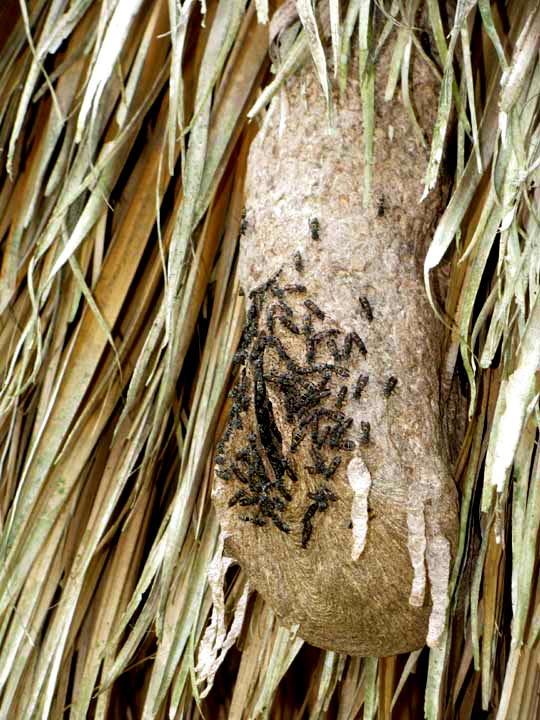
Upon my arrival the wasps were constructing the interior combs in which they'd raise their brood, but soon they began covering the combs with their coarse, gray paper made from chewed wood pulp. I watched the nest slowly take form day after day. You can see some wasps milling about their finished nest entrance below:
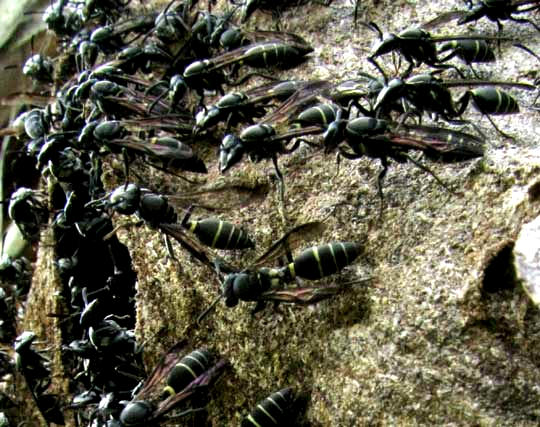
The wasps, which can deliver a moderately painful sting, never bothered me, always letting me stand close and watch, only occasionally darting at my face if I got too close, not stinging. The Maya, who accuse most reptiles and arthropods of every kind of devious and malicious intent to injury, admit that these wasps, which frequently live in their own hut thatch, hardly ever sting a hut's occupants. They say the wasps learn the hut owner's scent, and that only visitors need to take care.
And then about midday one day this week I returned to the hut to find a cloud of wasps buzzing around the nest, while on a Tree Cotton bush directly before the nest hundreds of them clustered as shown below:
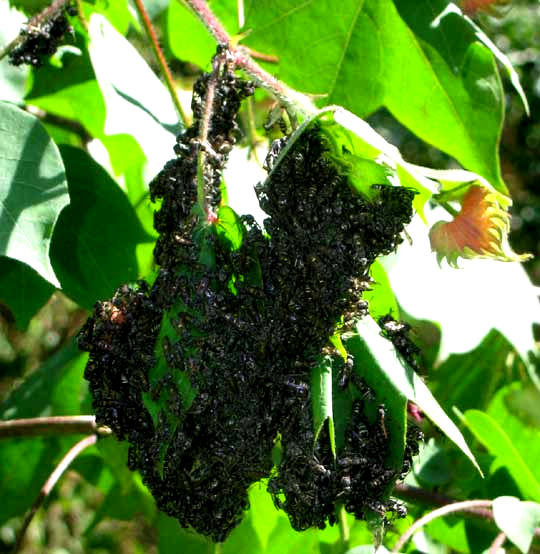
If they'd been bees, I'd have thought that somehow already the little nest had produced a surplus population and now a new queen was leading part of the nest to someplace else where a new nest would be founded. However, I wasn't sure if wasps did that. I looked more closely at the nest.
The nest was swarming not with wasps but with ants. Fair sized ants poured out of the thatch, rushed across the nest's surface into the nest's teardrop-shaped entry hole, while others were already leaving the hole carrying white, paperlike flakes. The flakes were borne to the nest's bottom, where they were released into the air to flutter to the ground. Then the ants returned to the hole. At first I thought the flakes were wasp wings but up close I saw that they were the coverings of brood cells.
The wasp nest was being overrun by ants. Part of the wasps had escaped and now clustered on the Tree Cotton while the ants methodically tore apart the nest's interior chambers holding developing wasp pupae. Then ants began exiting the hole, not very tenderly dragging larvae beneath them, their sharp, ice-tong-like mandibles stuck into the pupae as shown below:
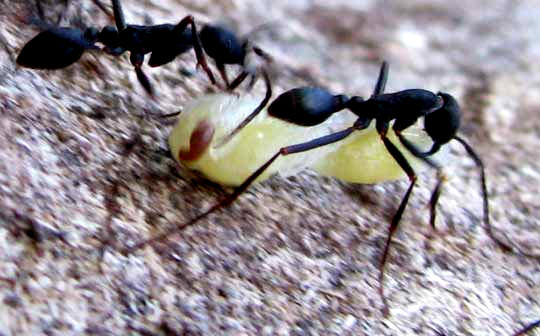
During this slaughter relative larger, red-headed soldier ants positioned themselves at the perimeter of action, their rear ends hunched beneath them as if they could sting, and their powerful mandibles open like incurved pincers ready to stab inwards, seen below:

In about half an hour the wasp swarm in the Tree Cotton departed. Until darkness fell the ants continued ripping open larval cells and carrying out white pupae, presumably to be butchered and distributed at their leisure.
The next morning the nest was empty, and quiet. During subsequent days from time to time wasps came and briefly surveyed the nest, but then flew away. Today the nest remains silent and abandoned.
By the way, down here the Maya still sometimes eat wasp larvae. There's a well illustrated recipe here.
from the July 13, 2018 Newsletter issued from Rancho Regenesis in the woods ±4kms west of Ek Balam Ruins; elevation ~40m (~130 ft), N~20.876°, W~88.170°; central Yucatán, MÉXICO
ANOTHER WASP NEST DISASTER
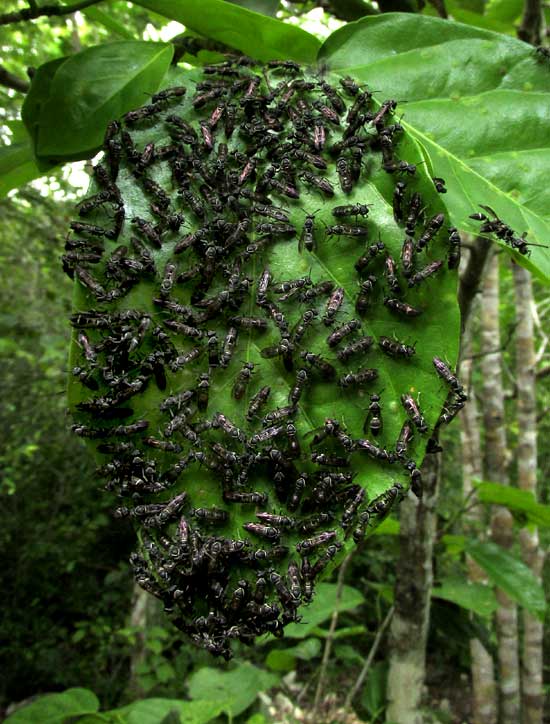
A close-up showing the species' characteristic markings is below:
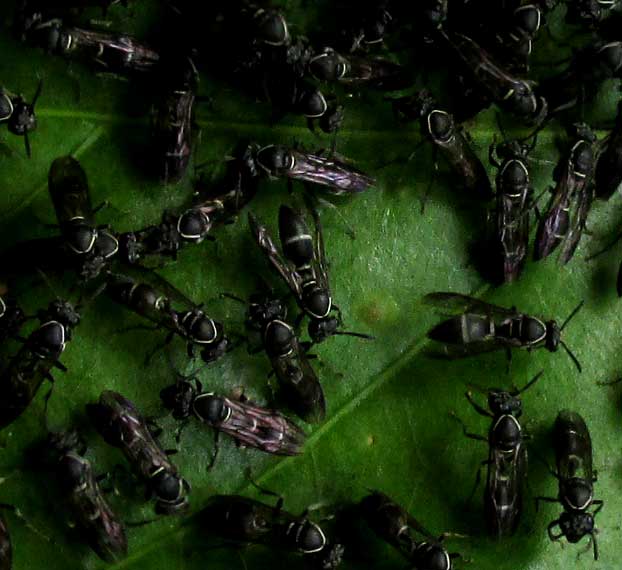
It didn't seem the right time of day and year for them to be swarming, here in the early rainy season with the heaviest rains still to come. When I sat at the porch table to think it over, I found the table and the porch's floor all around covered with small, white, bowl-shaped pieces of paper-like material, like confetti, as shown below:
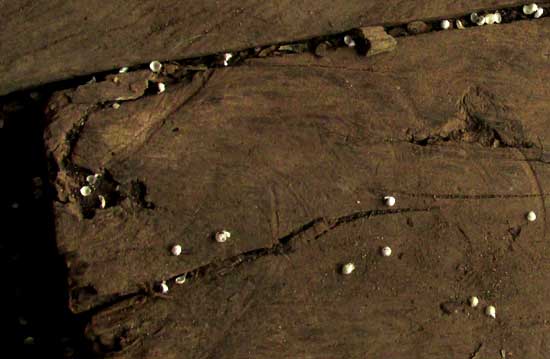
While sitting at the table, a piece of confetti fell onto my nose. I looked up, saw the wasp nest directly above, and realized that during the night the nest must have been attacked by army ants, as we've seen earlier. The nest is shown below:
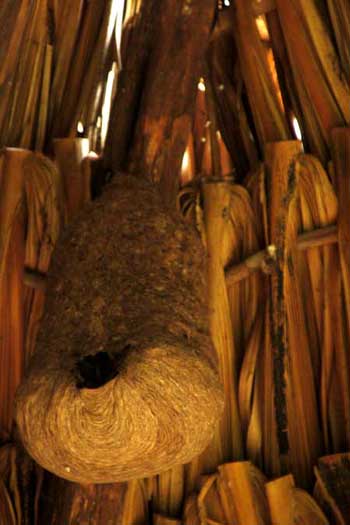
For the last year wasps have been busy tending to three or four nests suspended from the thatch roof of my hut and "porch." They don't bother me, though visitors sometimes get stung. That morning, no ants remained on the nest above me, but a few ranged about the floor, so I began looking at the hut's other nests. One of them inside hung over my sleeping place was in the process of being ravaged, the ants carrying off white wasp larvae, as documented during earlier encounters.
The next morning I awoke to find the hut's cement floor littered with shattered wasp nests. A flash-assisted shot of part of the floor is shown below:
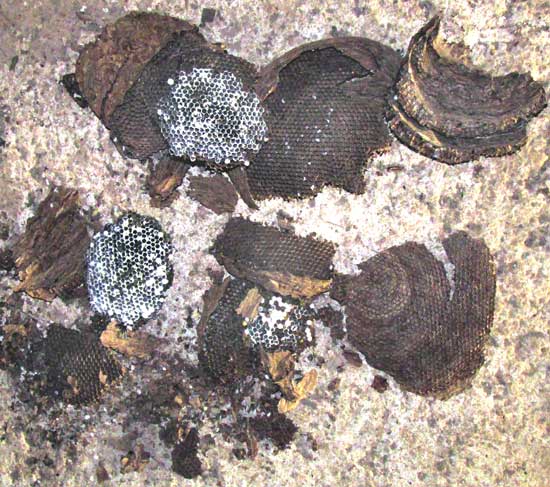
Woodrats living in the thatch roof, realizing that now the wasps were gone, had taken the liberty to ravage the nests, looking for larvae the army ants may have overlooked. I doubt that they found many, or any, for the ants are thorough.
Having some shattered nests handy, I was able to admire their structure. Below, you can see how various layers of hexagonal nesting chambers fit inside one another:

While the larvae are developing, their chambers are roofed with paper. The ants tore away those roofs, and the discarded paper made the confetti that fell onto the table and floor. Below, you can the empty chambers and remains of paper roofs:
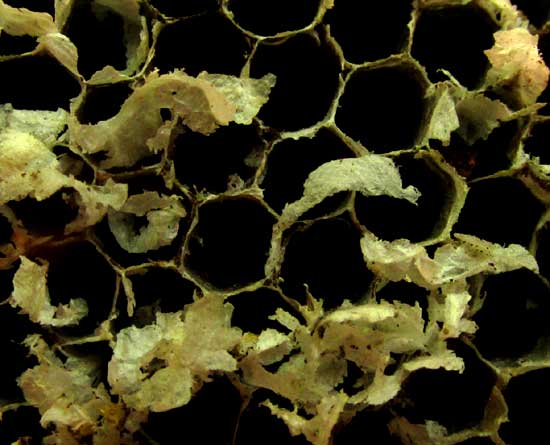
I sent some of the above pictures to wasp-nest enthusiast Terry Prouty, who conducts a FaceBook Wasp Group at https://www.facebook.com/groups/Vespids/
Terry thought that the nest had been constructed by the New World paper wasp genus Polybia. I found four Polybia species listed for the Yucatan, but pictures of those species didn't match the appearance of the wasps found on the Grape Tree leaf. But, here the plot thickens.
I'd left a bowl-like section of chamber-bearing nest on a wall, after taking the above close-up pictures. Later in the afternoon a single wasp appeared on the section, wandering around, examining the robbed chambers. She must have smelled the nest, maybe recognizing it as her own. And this lone wasp did indeed look like Terry's Polybia. Apparently the ants had robbed nests of more than one species at the hut. I'd photographed one species but focused on the nests of another.
The more I see of the Yucatan's remarkable diversity of paper-nest-building, predator wasp species, the more I'm convinced that most nests, maybe nearly all of them, are destroyed by army ants before the colonies reach maturity. However, with the abundance of nests to be seen, it's clear that enough colonies survive to perpetuate the species.
One almost feels sorry for the wasps, but then it's remembered that as they're building their nests they kill and butcher a large number of caterpillars. And then the caterpillars themselves were feeding on plants. And the individual plants were at war with their neighboring plants, competing for sunlight, water and nutrients...
from the May 15, 2016 Newsletter issued from Hacienda Chichen Resort beside Chichén Itzá Ruins, central Yucatán, MÉXICO
"EATING WASP"
During their lunchtime the white-uniformed folks who clean rooms and wash laundry called to me from their table beneath the Grapefruit tree. "¿Quieres comer avispa?," they asked, smiling grandly. "Avispa" means "wasp," so they seemed to be asking if I wanted to "eat wasp." Some here speak Spanish with a Maya accent that sometimes throws me for a loop, so I asked them to repeat, but sure enough they were saying "avispa." Don Cresencio opened a blue, plastic container on the table and then I understood. They were offering wasp larvae with scrambled eggs, a dish much appreciated in many parts of the world. Below you can see what the white-bodied, dark-headed grubs looked like scrambled with eggs:
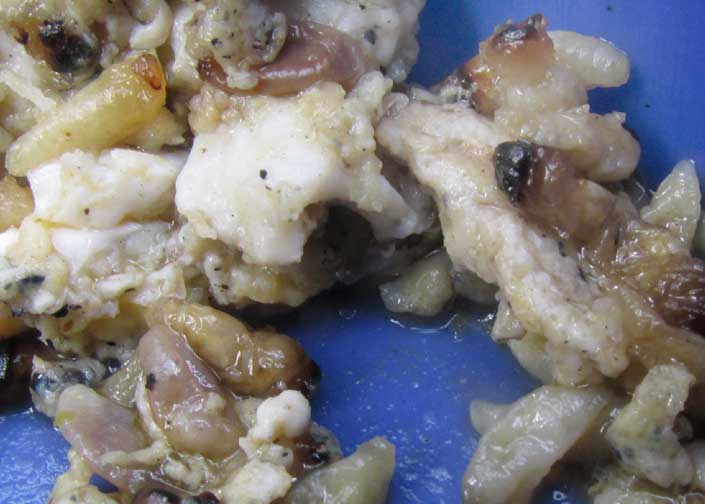
Someone at the table pointed to a nest like the one that had been robbed to get the larvae they were eating, hanging nearby about 20 feet up (6m) among branches of a newly leafed-out Ceiba tree, shown below:

When I was a child in Kentucky back in the 1950s it was common to see hornet nests similar to the one in the picture, though our Kentucky ones may have been a little larger. Nowadays up North they're almost never seen, probably because of habitat destruction and pesticide use. In this part of the Yucatan a somewhat smaller, narrower nest than is shown in the picture is much more common, so I asked if larvae from those nests also were good to eat. They are, but they're smaller and available in such small amounts that seldom they bother with them, especially not when these big, round ones are handy.
The Maya call the small, black wasps constructing these nests ek, which means "black," and sometimes say that they're eating ek. The ek's roundish hives contain combs in which each cell contains honey, an egg or a grub-type larva. Combs containing grubs are sometimes removed from nests and lain atop a fire's glowing embers. Once the grubs are scorched, they're removed from the comb's remains and eaten.
I didn't eat the portion they'd saved for me, explaining once again that I'm a vegetarian and that for me that means I don't eat animals. Here many people think that vegetarians merely avoid eating larger animals -- and that they eat them, too, if they feel like it -- and can hardly believe that I won't eat fish or chickens, much less "avispas," ever.
But, already I was feeling sorry for the colony of wasps that had been destroyed just to add a little different flavor and a certain crunchiness to the fried eggs.